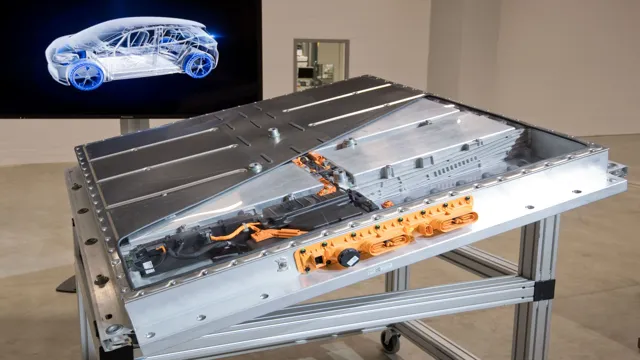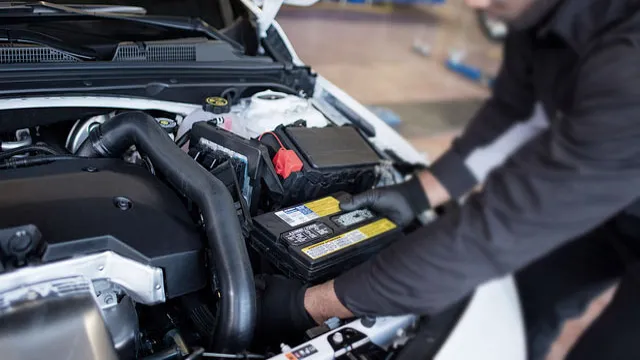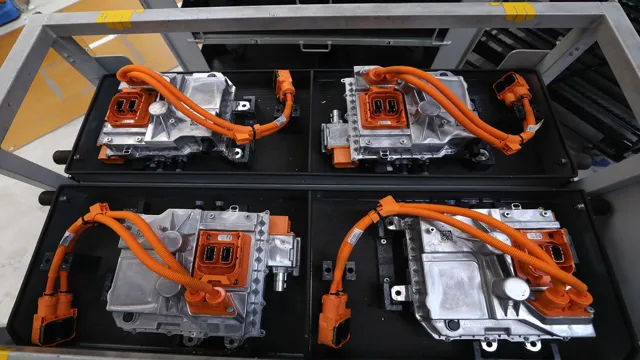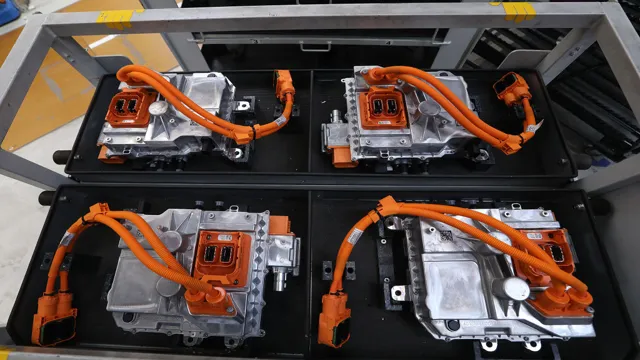Exploring the Potential of Changing Electric Car Batteries: Here’s Everything You Need to Know
Electric cars have come a long way in recent years, with increasing numbers of people choosing to ditch their gas-guzzling vehicles in favor of more eco-friendly options. One of the big draws of electric cars is their low maintenance, but that doesn’t mean they’re maintenance-free. Just like any other car, electric vehicles require attention and upkeep, including the occasional battery replacement.
In this blog post, we’ll take a closer look at what it means to change an electric car battery, why you might need to do it, and how to go about the process. Whether you’re a seasoned electric car owner or just getting started, this article will provide you with some valuable insights and real-world tips to help you keep your vehicle running smoothly.
Why You Might Need to Replace Your Battery
Can you change an electric car battery? Well, the answer is yes, you can. While electric car batteries have come a long way in terms of lifespan, they are not meant to last forever. Eventually, they will need to be replaced, either due to age or wear and tear.
Some signs that your electric car battery might need to be replaced include reduced driving range, slower charging times, and decreased overall performance. It’s important to note that replacing an electric car battery can be expensive, with costs ranging from several thousand to tens of thousands of dollars. However, it’s often a necessary expense to keep your electric vehicle running smoothly and reliably.
If you’re experiencing battery-related issues with your electric car, it’s best to consult with a professional mechanic or dealership to determine the best course of action.
Warning Signs of a Failing Battery
As a car owner, one of the most frustrating experiences is realizing that you left your headlights on and your battery has died. But that’s not the only warning sign that your battery is failing. One major clue is difficulty starting your vehicle.
If you find yourself struggling to turn the key or experiencing a delay before your engine starts, it could be a sign that your battery is losing its power. Other warning signs include dimming headlights, a slow power delivery, and corrosion on the battery itself. If you notice any of these symptoms, it might be time to consider replacing your battery.
By doing so, you can avoid the stress and inconvenience of a breakdown while on the road.
Average Lifespan of an Electric Car Battery
The average lifespan of an electric car battery is an important factor to consider when deciding to purchase an electric vehicle. Most manufacturers claim that the batteries can last anywhere between 8-10 years or up to 100,000 miles. However, several factors can impact the life of the battery, such as the frequency of charging, temperature, and even driving habits.
If your electric car battery starts to fail, it might be necessary to replace it. While it can be expensive, it’s still a cost-effective alternative to purchasing a whole new electric car. Additionally, several car manufacturers offer battery replacement programs, making it easier for car owners to replace their batteries without breaking the bank.
If you’re worried about prolonging your battery’s lifespan, it’s best to keep your electric car charged to appropriate levels, avoid exposing it to extreme temperatures, and seek professional help if you notice any issues.
Finding the Right Replacement Battery
Can you change an electric car battery? Absolutely! But finding the right replacement battery can be a bit tricky. Unlike traditional gasoline-powered cars, electric cars require specialized batteries that provide enough power to run the vehicle. When you need to replace your electric car battery, it’s important to know the specific type of battery your car needs and the manufacturer’s recommendations.
Factors to consider include battery size, power output, and charging capacity. Additionally, you may want to consider the cost of the replacement battery and how long it will last to ensure you get the best value for your money. While swapping out an electric car battery may seem intimidating, it’s actually a relatively straightforward process that can be done by professionals or knowledgeable DIYers with the right tools and equipment.
With the right replacement battery and a little know-how, you can keep your electric car running smoothly for years to come.
Compatibility with Your Car Model
One of the most important things to consider when looking for a replacement car battery is compatibility with your specific car model. Every vehicle has unique electrical requirements, and the wrong battery could cause performance issues or even damage to your car. When replacing your battery, be sure to consult your car’s owner manual or a trusted mechanic to determine the correct size, voltage, and polarity for your make and model.
Additionally, consider factors such as the climate you live in and the average driving conditions you encounter. An AGM battery may be better suited for harsh temperatures, while a high-performance battery may be necessary for those who frequently use power-hungry accessories such as a sound system or GPS. By taking the time to research and choose the right replacement battery, you can ensure safe and efficient operation of your vehicle.
Cost Factors to Consider
Finding the right replacement battery for your device can be both confusing and overwhelming. With so many options available to choose from, it’s essential to consider various cost factors. Firstly, you’ll want to closely examine the cost of the battery itself.
While cheaper batteries may seem like a good deal upfront, they may not last as long, costing you more money in the long run through frequent replacements. On the other hand, investing in a high-quality, longer-lasting battery may come with a more expensive price tag, but could be more cost-effective in the long term. Another cost factor to consider is the installation cost.
While some batteries may be easy to replace yourself, other devices may require professional installation, which can add additional costs. It’s essential to research and compare installation costs between different batteries before making a final decision. By considering both the cost of the battery itself and the installation process, you can help ensure you’re making the best decision for your device and your budget.
Warranty and Maintenance Options
When it comes to finding the right replacement battery for your vehicle, it can be overwhelming with all the options available in the market. It is essential to keep in mind the specific make and model of your car, as well as the type of battery that is compatible. Lead-acid batteries are widely used and tend to be the most affordable.
Still, some vehicles may require lithium-ion batteries or other specialized types. It is crucial to consult your owner’s manual or a trusted mechanic to ensure you choose the right battery for your vehicle. Moreover, considering warranty and maintenance options is also crucial, as investing in a high-quality battery can save you money in the long run.
It is always best to do your research, compare prices, and choose a reputable brand to ensure the longevity and performance of your replacement battery.
The Process of Changing Your Battery
Yes, you can change an electric car battery, but the process can be a bit tricky. Generally, it is recommended to replace the battery in an electric car after 5-7 years, depending on the model and manufacturer. Before attempting to replace the battery, it is essential to check the car’s manual to ensure that you have the necessary tools and skills to perform the task correctly.
Electric car batteries are much larger and heavier than traditional car batteries and require different tools to remove and install them. You’ll need to disconnect the battery entirely by disconnecting the negative cable first, followed by the positive. Then, you’ll need to remove the battery mounting bolts and take out the old battery.
Installing the new battery is the reverse of the removal process but follows any additional instructions in the manual. Always ensure your safety when changing an electric car battery and consider seeking professional assistance if you’re unsure.
Safety Precautions to Take
Safety precautions to take when changing your battery are essential to follow to avoid any risks. Firstly, it is recommended to read your vehicle manual before you start any work. This will help in understanding the battery type and location.
Secondly, ensure that the engine is not running before attempting to take out your battery. Remove keys from the ignition and turn off all electrical systems. Next, wear protective gear such as gloves and goggles to protect yourself from acid spills.
Always disconnect the negative cable first and retain it up and away from the battery. When disconnecting the positive terminal, make sure it does not come into contact with the negative terminal. To avoid damages, use a wrench to loosen and release any battery clamps holding the battery in place.
Take out the old battery and keep it away from flammable materials. Lastly, install the new battery carefully following the reverse order of the removal process. Safety measures should be taken seriously when changing your battery to ensure a smooth process and avoid any health hazards.
Tools and Equipment You Will Need
When it comes to changing your car’s battery, it’s important to have the right tools and equipment on hand to make the process as seamless as possible. The tools you will need include a wrench or socket set, a pair of pliers, safety goggles, and gloves to protect your hands from battery acid. It’s also a good idea to have a portable jump starter or battery charger in case you run into any issues.
The process of changing your battery involves disconnecting the negative and positive terminals from the old battery, removing the battery from its housing, cleaning the battery tray, and installing the new battery in its place. Make sure to follow the manufacturer’s instructions carefully, as they may vary depending on the type of vehicle you have. By having the right tools and following the proper steps, you can successfully change your car’s battery and keep it running smoothly on the road.
Conclusion
In conclusion, changing an electric car battery is not a task for the faint of heart. It requires technical expertise, specialized equipment, and a healthy dose of courage (or at least a willingness to follow instructions). But, fear not, intrepid electric vehicle owners! With a bit of patience and perseverance, even the most tech-challenged among us can learn how to swap out our EV batteries like a pro.
So don’t be afraid to take that DIY plunge – just be sure to keep a charged sense of humor handy in case of any unexpected roadblocks!”
FAQs
How long does an electric car battery typically last?
Electric car batteries can last anywhere from 8 to 20 years, depending on usage and maintenance.
Can an electric car battery be replaced?
Yes, electric car batteries can be replaced, but it can be costly.
Do all electric cars use the same type of battery?
No, different electric car models use different types of batteries, such as lithium-ion, nickel-metal hydride, or solid-state batteries.
What is the lifespan of a lithium-ion battery used in an electric car?
The lifespan of a lithium-ion battery used in an electric car can range from 5 to 15 years, depending on the manufacturer and usage. Some manufacturers offer warranties for up to 8 years or 100,000 miles.






